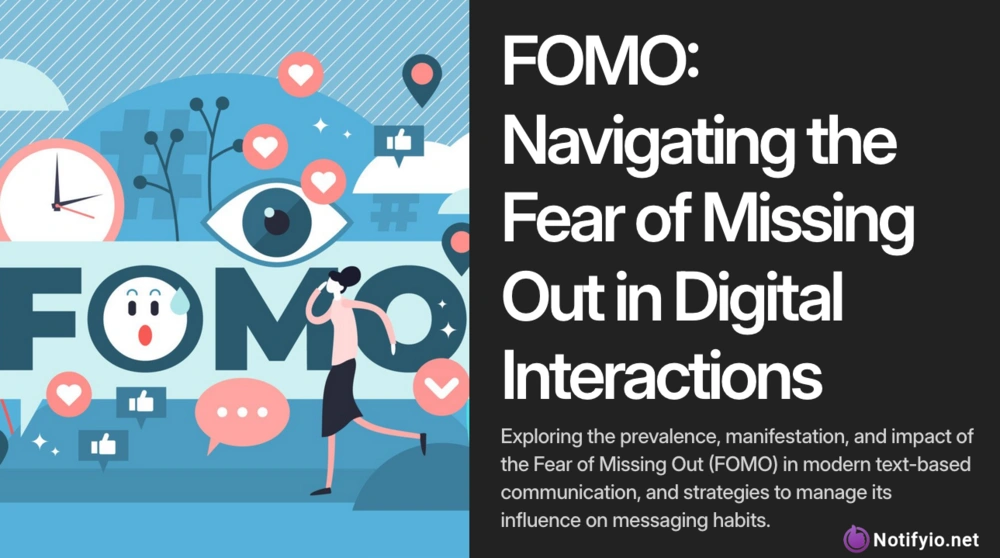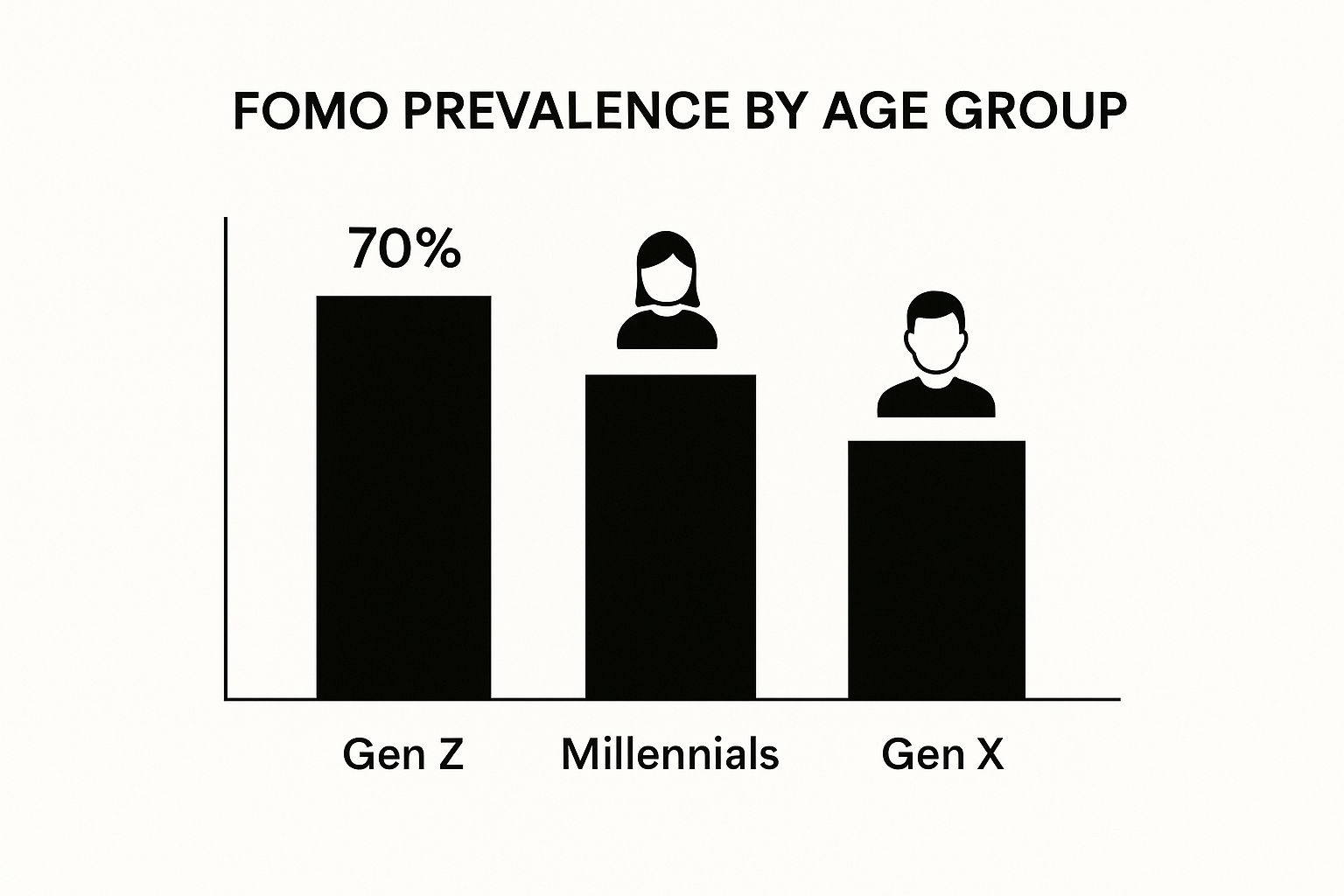Decoding FOMO: The Hidden Language of Digital Anxiety
Ever feel that magnetic pull towards your phone, almost like an itch you have to scratch? That feeling isn’t just a quirky modern habit. It often points to something deeper running beneath the surface of our online lives.
The fear of missing out, better known as FOMO, has quietly become part of how we interact digitally. It’s moved beyond a vague social worry and now shows up in specific ways within our texts, DMs, and comment threads. Understanding the FOMO meaning in text involves more than just spotting the letters F-O-M-O.
It’s like learning a secret code typed out on keyboards and screens. This digital shorthand often carries an undercurrent of anxiety – worrying about being left out, needing to belong, or struggling to stay in the loop. The messages flying back and forth can be clues pointing back to this core fear.

Textual Clues to Digital Unease
Spotting FOMO in digital chats often means reading between the lines. Subtle signs can give away this underlying unease:
- Response Timing: A lightning-fast reply, maybe even interrupting something happening offline, can show an urgent need to stay connected. On the flip side, sometimes anxiety leads to slow responses because someone is overthinking the ‘perfect’ reply.
- Question Patterns: Constantly asking things like “What’s everyone doing?”, “Did I miss anything big?”, or asking a lot of questions about what others are up to can be a FOMO flag.
- Specific Phrasing: You might see comments dripping with envy (“Looks fun, wish I could’ve been there!”) or messages subtly asking for an invite (“Keep me posted for the next one!”). These are pretty common signals.
The influence of FOMO is quite real, especially for younger generations who basically grew up with social media feeds. Research actually shows that a significant 69% of millennials say they experience FOMO. This feeling is often fueled by the always-on nature of social platforms.
It’s not just a feeling, either—it makes people act. A notable 60% admit they’ve bought something impulsively just because they didn’t want to feel left out of a trend or event. Discover more insights about FOMO statistics here.
These numbers show how deeply FOMO affects not only what we buy but also how we talk to each other online, as we try to stay constantly updated and included. How FOMO appears can also change quite a bit depending on age or the situation – a work chat will look different from a casual text chain with friends. Learning to notice these small digital hints gives us a better handle on our own online habits and helps us understand the people we connect with.
The Language of Left Out: Identifying FOMO Text Patterns

Sometimes, feelings of FOMO (Fear of Missing Out) are stated plainly, like admitting jealousy over missing an event. However, the true fomo meaning in text often hides in less obvious language habits. These patterns aren’t just simple statements; they show an underlying worry about being excluded digitally through word choice and message structure.
Spotting these signs means paying attention to how someone texts, not just what they text.
Subtle Textual Indicators
Certain ways of writing can be clues that someone feels left out. For example, using a lot of punctuation, like several question marks (“Did you guys do anything fun???” ) or exclamation points (“Wow, looks like a great time!!!!”), might signal extra emotion or anxiety about not having all the details.
Here are other subtle signs to look for:
- Constant Check-ins: Sending messages like “What’s up with everyone?” or “Anything happening?” often can suggest a need for confirmation that they aren’t missing out.
- Time-Stamping: Pointing out activity (“Saw you were online late…”) can be a soft way to ask about conversations or events they weren’t involved in.
- Narrative Fishing: Asking broad questions meant to draw out information about a missed event or chat, without directly saying “Tell me what happened.” An example is, “Hope the party was good!” which prompts others to share specifics.
- Downplaying Absence: Using phrases such as “Just checking in” or starting questions with “Sorry if this was already covered…” might be attempts to rejoin a conversation smoothly while hiding anxiety about being excluded.
Context Matters: FOMO Across Platforms
How FOMO shows up in text changes based on the setting. In work-related Slack channels or Microsoft Teams chats, FOMO might look like posting unnecessary updates or checking in too often on project threads. This can stem from a fear of missing vital work information or professional chances.
On the other hand, in relaxed group chats on apps like WhatsApp or Messenger, FOMO frequently appears as quick-fire questions or comments showing envy about social gatherings. The core worry is identical, but how it’s expressed fits the situation and what’s socially at stake.

To help identify these patterns, the table below outlines common textual expressions indicating FOMO.
Common FOMO Indicators in Text Communications
This table categorizes and explains the most frequent textual expressions that indicate FOMO across different platforms.
| FOMO Expression | Common Context | Underlying Meaning | Platform Where Most Common |
|---|---|---|---|
| Rapid-fire questions | Group chat after an event or shared experience | Anxiety about missing key details or inside jokes | WhatsApp, Messenger, Discord |
| “Wish I was there” comments | Replying to photos/updates of an event | Explicit expression of envy and feeling left out | Instagram, Facebook, Texts |
| Frequent check-ins/status pings | Professional or project-based channels | Fear of missing important updates or being overlooked | Slack, Microsoft Teams |
| Excessive emoji/punctuation use | Casual chats discussing plans or events | Heightened emotion, urgency, or anxiety | Texts, Social Media DMs |
| “Narrative Fishing” questions | Any group chat where user feels excluded | Seeking information indirectly to gauge what was missed | Most messaging apps |
Understanding these text habits often reveals a basic human need for belonging and validation. Recognizing the subtleties of the fomo meaning in text allows us to look past the literal words and see the desire for connection that motivates the messages.
Why Your Brain Craves Digital Inclusion

Spotting the signs of FOMO in messages is one part of the puzzle. But figuring out why these feelings pop up tells us a lot about how we’re wired as humans. The psychology behind the fear of missing out isn’t just about feeling left out socially; it connects directly to our basic need to belong.
Our brains evolved to prioritize social connection. Back in the day, being part of the group was essential for survival. That deep need is still with us, but now it plays out in our online interactions. Texting, however, changes the game for how we gauge social acceptance, often leaving our brains guessing.
The Ambiguity of Text
Imagine chatting with someone face-to-face. You get instant feedback from their tone, expressions, and body language. Text messages remove all of that, leaving just the words on the screen. So, when a reply takes hours, your brain doesn’t have the full picture. Are they just busy, or are you being ignored?
Without those non-verbal signals, our minds tend to jump to negative conclusions, filling the void with anxiety. This uncertainty is a key part of the fomo meaning in text. A simple delay can feel like a rejection, even if the sender didn’t mean it that way. Because texts feel somewhat permanent, the social pressure of each message can feel higher.
Neurological Nudges and Platform Design
Many messaging apps have features that can actually make these feelings stronger. Think about things like:
- Read Receipts: Seeing “read” without a quick response can easily spark anxiety about being ignored.
- Typing Indicators: Those little bubbles show someone is typing, but if they vanish without a message appearing, it can make you wonder what happened and feel uneasy.

These tools, though sometimes helpful, directly poke at our brain’s sensitivity to social cues. FOMO isn’t just a personal worry; it can impact mental well-being and online habits, pushing people to check their phones constantly.
In fact, research indicates 56% of social media users admit to feeling FOMO, which can feed into feelings of inadequacy if not kept in check. Explore this topic further.
It’s possible that platforms are aware of how these features affect us and sometimes design them to encourage more frequent checking by tapping into our need for connection. Plus, different people react differently to these digital cues; some find the lack of clarity and the lasting nature of text particularly stressful, making them more prone to text-based FOMO.
When FOMO Hijacks Your Messaging Habits

That little nagging feeling that you might be missing out on something important can slowly become a bigger issue. When the fear of missing out really digs in, it can start influencing how often and why you send texts or direct messages, turning occasional worry into steady habits.
This change doesn’t usually happen overnight. Maybe you started just wanting to keep up with friends, but now feel an almost constant urge to check for new messages or reply immediately. The meaning of FOMO in texting starts to shift away from the actual conversation and focuses more on the actions behind it – like sending too many messages, feeling anxious if someone takes a while to reply, or finding it hard to put your phone down.
This sense of urgency directly influences what we do. It leads to noticeable changes in behavior, such as constantly checking social media feeds or message notifications. For instance, studies reveal that 45% of people experiencing FOMO struggle to go more than 12 hours without checking their social media, showing just how strong this need to stay in the loop can be. Find more detailed statistics here. This continuous need for connection reshapes how we communicate digitally.
Warning Signs Your Texts Are FOMO-Driven
So, how can you tell if FOMO is more than just a passing thought and is actually shaping your messaging habits? Watch out for these behaviors:
- Losing Sleep: Frequently waking up during the night just to check messages or feeling anxious about conversations you might have missed while sleeping.
- Always Watching Chats: Feeling compelled to keep an eye on group chats or message threads you’re not even part of, simply to stay updated.
- Worrying About Digital Connections: Getting overly stressed about how quickly you or others respond to messages, or feeling insecure about your social status online.
- Ignoring Real Life: Often pausing face-to-face conversations, meals, or important tasks to check or answer messages that aren’t urgent.
These actions can trap you in demanding communication loops. The constant pressure to be available can lead to digital burnout. Plus, these habits gradually weaken the necessary separation between your online life and your offline activities.

The effects can ripple through different parts of your life. At work, it could mean less focus and difficulty meeting deadlines. In your personal life, it might put a strain on relationships because real-world interactions get pushed aside. Ultimately, messaging habits driven by FOMO can seriously impact your mental wellbeing, leading to increased stress and anxiety. Spotting these signs is the essential first move toward managing your digital communication better.
Platform by Platform: How Each App Triggers FOMO
While the unease driven by messaging habits can affect anyone, how this anxiety shows up often changes depending on the digital space you’re in. Various social media apps and platforms have unique designs and features that, intentionally or not, tap into our fear of missing out. Figuring out the fomo meaning in text across different apps means examining how their basic functions shape our experiences.

Not every FOMO trigger is obvious; often, they are subtle design elements integrated into how we use the app.
The Urgency Engines: Ephemeral Content and Real-Time Feeds
Platforms such as Instagram and Snapchat were early adopters of ephemeral content – think Stories that vanish after 24 hours. This temporary aspect naturally creates a feeling of urgency. You feel compelled to check often, otherwise, you risk missing brief moments or inside jokes, increasing the sense that you might be excluded.
Similarly, platforms like Twitter rely heavily on real-time updates. The non-stop flow of conversations and news can make users feel they need to be constantly connected. Falling behind the feed might feel like missing out socially and on important information, making the anxiety of exclusion worse.
Metrics and Visibility: The Social Pressure Cooker
Other apps generate pressure through visibility. Public numbers like like counts, view counts, and follower numbers on applications like Instagram and Facebook serve as ongoing social gauges. Seeing others get lots of engagement or share only their best moments can spark social comparison and feelings of not measuring up.
This comparison is a major source of FOMO. The data chart visualized above illustrates how specific platform features are frequently identified by users as anxiety sources. For example, user surveys reveal that public like counts (cited by 45% of users) and seeing others’ event check-ins (38%) are substantial FOMO triggers. This visual comparison underscores how transparency into the curated activities and lives of others directly feeds the fear of missing out.
To better understand how these triggers differ, the table below compares FOMO manifestations across key digital platforms.
FOMO Across Digital Platforms: A Comparison
This table compares how FOMO manifests differently in text across major social media and messaging platforms
| Platform | Primary FOMO Triggers | Common Text Expressions | Unique Characteristics |
|---|---|---|---|
| Instagram, Snapchat | Ephemeral content (Stories), highlight reels, like counts | “Did you see their story before it disappeared?” “Wish I was there!” | Creates urgency via temporary content; fuels comparison |
| Twitter (X) | Real-time news feed, trending topics | “What’s everyone talking about?” “I feel so out of the loop.” | Constant stream demands continuous attention to stay current |
| Event check-ins, relationship statuses, like counts | “Looks like everyone went to that party.” “Their life seems perfect.” | Focuses on life events and social validation | |
| WhatsApp, Messenger, iMessage | Read receipts (‘seen’), activity status (‘online’) | “They saw my message but didn’t reply…” “Why are they online but not responding?” | Pressure around response times and perceived availability |
This comparison highlights that while FOMO is widespread, the specific features of each platform shape how we experience it, from the rush of disappearing content to the pressure of visible metrics and response expectations.
The Response Game: Messaging Apps and Activity Indicators
Even direct messaging apps contribute to FOMO. Common features in WhatsApp, Messenger, and iMessage, like read receipts (those “seen” indicators) and activity statuses (“online,” “last seen”), heighten the pressure related to response times. Noticing someone read your message but hasn’t replied can cause anxiety.
On the flip side, feeling you must reply instantly because someone sees you’re “online” adds another stress layer. These features transform simple text chats into a subtle dance of presence and availability, directly impacting the anxiety tied to the fomo meaning in text. Recognizing these platform-specific triggers helps us see how different digital environments mold our social anxieties and interaction habits, sometimes as part of efforts to improve brand credibility and user interaction.
Breaking the FOMO Text Cycle
Do you feel stuck constantly checking your phone, afraid you’ll miss out on something important? It’s definitely possible to get back some control over your digital life. Tackling text-based FOMO (Fear Of Missing Out) isn’t about ditching your phone altogether, but rather about finding healthier ways to stay connected that work for you.
Figuring out the fomo meaning in text isn’t just about knowing it causes anxiety; it’s about actively learning how to handle it. This begins by making deliberate choices about when and how you interact with your messages and devices.
Managing Notifications Wisely
Those endless pings and pop-ups are designed to keep pulling you back, feeding that fear of missing something crucial. Getting a handle on your notifications is a big step toward feeling calmer. Try these approaches:
- Be Selective: Switch off notifications for apps that aren’t critical or for group chats that often cause stress. Keep alerts active only for close contacts or genuinely urgent updates.
- Batch Checking: Instead of jumping every time your phone buzzes, pick a few specific times each day to check and answer messages. This approach puts you back in the driver’s seat.
- Use Focus Modes: Most phones have features like “Do Not Disturb” or customizable Focus modes. Use these to silence notifications when you need to concentrate on work, sleep, or just be present with family.
It’s also helpful to know that social media platforms often design their systems to trigger FOMO. This keeps users engaged, which benefits their advertising income. Being aware of how these platforms operate and influence our habits highlights why managing your digital space is so vital for your mental health. Discover more insights about social media’s influence here.
Setting Healthy Response Expectations
That unspoken rule about replying instantly can really ramp up text anxiety. You have the power to gently change these expectations, both for yourself and with others. Let people know your boundaries kindly – maybe tell friends you usually catch up on messages in the evenings.
This also involves giving others some breathing room. Understand that people reply at different speeds based on their own lives. Respecting their timing helps build a communication style that’s less demanding for everyone. Setting realistic expectations is key to reducing that constant FOMO-driven urgency.
Crafting Mindful Messages
You can also lessen FOMO through how you communicate. Aim for messages that connect with others without making anyone feel more anxious. If you have to miss out on plans, express good wishes simply, maybe like: “Hope you all have a fantastic time!” instead of dwelling on what you’re missing.
When you need to set a boundary, be clear but kind. For example, if a chat is getting too much, you could say, “Hey everyone, I’m trying to reduce my screen time, so my replies here might be slower.” Honest communication prevents confusion and can make FOMO less intense for everyone involved. Adopting these habits helps shift the fomo meaning in text from a source of stress to a space for thoughtful connection.
The Evolution Of Digital FOMO: What Comes Next
As people set clearer boundaries around their messages, designers and researchers are already exploring how fomo meaning in text will change with new technologies. From AI assistants prompting us to reply faster to augmented reality overlays that blend digital and physical spaces, the way we feel anxious about missing out is shifting.
Voice Messaging And The Rush To Respond
Voice notes bring tone and emotion but they raise the stakes. Unlike text, a recorded message captures pace and inflection, which can trigger:
- Instant-play expectations: Listeners worry they must respond at once or seem impolite
- Multimodal anxiety: Juggling voice and text means even more channels to monitor
- Loss of editability: Unable to revise spoken words, users often second-guess what they said
While voice messaging can deepen connections, it also creates new FOMO rhythms that blur real-time chat and delayed responses.
Augmented Reality Chats: FOMO In Mixed Reality Spaces
Imagine joining a group call where everyone’s avatar appears in your living room. AR chats promise richer presence—and fresh forms of exclusion anxiety:
- Real-time presence indicators
- Shared virtual “hangouts” that disappear when you log off
- Visual activity cues in virtual workspaces
With 72% of users expecting seamless AR experiences by 2027, missing a digital meetup may feel as awkward as skipping an in-person event. Designers must balance immersion with mental health safeguards so that being online never feels mandatory.
AI Assistants And Personalized FOMO Triggers
Machine learning can now study your messaging habits and nudge you to jump back into conversations. For marketers, this level of personalization offers a powerful lever:
- AI-driven prompts recommend the best time to send replies
- Sentiment analysis flags discussions you “should” join
- Notification bots recap threads you missed

As FOMO continues to shape consumer choices, understanding its reach is vital for any marketing strategy. Find more detailed statistics here
Comparing Emerging FOMO Drivers
| Trend | FOMO Trigger | Potential Wellbeing Feature |
|---|---|---|
| Voice Messaging | Urgency to listen and reply instantly | Optional “Reply Later” queue |
| Augmented Reality Chats | Visual and spatial presence indicators | Presence “snooze” in shared AR rooms |
| AI Assistants | Personalized follow-up prompts | AI-recommended downtime for digital breaks |
| Real-Time Translation Tools | Pressure to keep up in multilingual chats | Auto-summaries with “opt-in” conversation glance |
Looking ahead, features like scheduled quiet hours, AI-moderated sentiment nudges, and clearer response expectations can help curb FOMO-driven stress. Yet each new capability also risks introducing fresh patterns of exclusion.
Ready to stay ahead of evolving FOMO trends? Discover how strategic social proof and conversion tactics can keep your audience connected—visit Notifyio today.




Leave a Reply